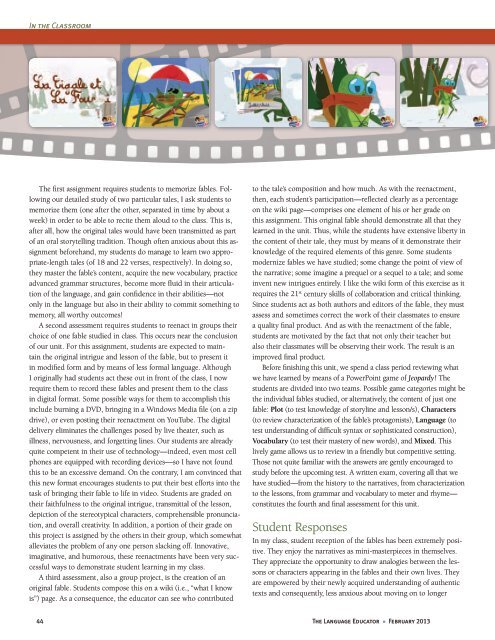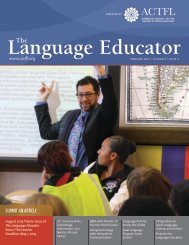You also want an ePaper? Increase the reach of your titles
YUMPU automatically turns print PDFs into web optimized ePapers that Google loves.
In the Classroom<br />
The first assignment requires students to memorize fables. Following<br />
our detailed study of two particular tales, I ask students to<br />
memorize them (one after the other, separated in time by about a<br />
week) in order to be able to recite them aloud to the class. This is,<br />
after all, how the original tales would have been transmitted as part<br />
of an oral storytelling tradition. Though often anxious about this assignment<br />
beforehand, my students do manage to learn two appropriate-length<br />
tales (of 18 and 22 verses, respectively). In doing so,<br />
they master the fable’s content, acquire the new vocabulary, practice<br />
advanced grammar structures, become more fluid in their articulation<br />
of the language, and gain confidence in their abilities—not<br />
only in the language but also in their ability to commit something to<br />
memory, all worthy outcomes!<br />
A second assessment requires students to reenact in groups their<br />
choice of one fable studied in class. This occurs near the conclusion<br />
of our unit. For this assignment, students are expected to maintain<br />
the original intrigue and lesson of the fable, but to present it<br />
in modified form and by means of less formal language. Although<br />
I originally had students act these out in front of the class, I now<br />
require them to record these fables and present them to the class<br />
in digital format. Some possible ways for them to accomplish this<br />
include burning a DVD, bringing in a Windows Media file (on a zip<br />
drive), or even posting their reenactment on YouTube. The digital<br />
delivery eliminates the challenges posed by live theater, such as<br />
illness, nervousness, and forgetting lines. Our students are already<br />
quite competent in their use of technology—indeed, even most cell<br />
phones are equipped with recording devices—so I have not found<br />
this to be an excessive demand. On the contrary, I am convinced that<br />
this new format encourages students to put their best efforts into the<br />
task of bringing their fable to life in video. Students are graded on<br />
their faithfulness to the original intrigue, transmittal of the lesson,<br />
depiction of the stereotypical characters, comprehensible pronunciation,<br />
and overall creativity. In addition, a portion of their grade on<br />
this project is assigned by the others in their group, which somewhat<br />
alleviates the problem of any one person slacking off. Innovative,<br />
imaginative, and humorous, these reenactments have been very successful<br />
ways to demonstrate student learning in my class.<br />
A third assessment, also a group project, is the creation of an<br />
original fable. Students compose this on a wiki (i.e., “what I know<br />
is”) page. As a consequence, the educator can see who contributed<br />
44<br />
to the tale’s composition and how much. As with the reenactment,<br />
then, each student’s participation—reflected clearly as a percentage<br />
on the wiki page—comprises one element of his or her grade on<br />
this assignment. This original fable should demonstrate all that they<br />
learned in the unit. Thus, while the students have extensive liberty in<br />
the content of their tale, they must by means of it demonstrate their<br />
knowledge of the required elements of this genre. Some students<br />
modernize fables we have studied; some change the point of view of<br />
the narrative; some imagine a prequel or a sequel to a tale; and some<br />
invent new intrigues entirely. I like the wiki form of this exercise as it<br />
requires the 21 st century skills of collaboration and critical thinking.<br />
Since students act as both authors and editors of the fable, they must<br />
assess and sometimes correct the work of their classmates to ensure<br />
a quality final product. And as with the reenactment of the fable,<br />
students are motivated by the fact that not only their teacher but<br />
also their classmates will be observing their work. The result is an<br />
improved final product.<br />
Before finishing this unit, we spend a class period reviewing what<br />
we have learned by means of a PowerPoint game of Jeopardy! The<br />
students are divided into two teams. Possible game categories might be<br />
the individual fables studied, or alternatively, the content of just one<br />
fable: Plot (to test knowledge of storyline and lesson/s), Characters<br />
(to review characterization of the fable’s protagonists), Language (to<br />
test understanding of difficult syntax or sophisticated construction),<br />
Vocabulary (to test their mastery of new words), and Mixed. This<br />
lively game allows us to review in a friendly but competitive setting.<br />
Those not quite familiar with the answers are gently encouraged to<br />
study before the upcoming test. A written exam, covering all that we<br />
have studied—from the history to the narratives, from characterization<br />
to the lessons, from grammar and vocabulary to meter and rhyme—<br />
constitutes the fourth and final assessment for this unit.<br />
Student Responses<br />
In my class, student reception of the fables has been extremely positive.<br />
They enjoy the narratives as mini-masterpieces in themselves.<br />
They appreciate the opportunity to draw analogies between the lessons<br />
or characters appearing in the fables and their own lives. They<br />
are empowered by their newly acquired understanding of authentic<br />
texts and consequently, less anxious about moving on to longer<br />
The Language Educator n February 2013



